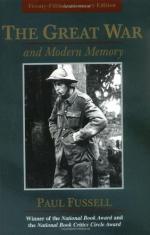|
This section contains 475 words (approx. 2 pages at 400 words per page) |

|
The Great War and Modern Memory Summary & Study Guide Description
The Great War and Modern Memory Summary & Study Guide includes comprehensive information and analysis to help you understand the book. This study guide contains the following sections:
This detailed literature summary also contains Topics for Discussion and a Free Quiz on The Great War and Modern Memory by Paul Fussell.
The Great War and Modern Memory by Paul Fussell is a look at primarily the literature of World War I. Fussell looks at the different myths, themes, and kinds of things that come about because of the situation of war. The literary style changed because of the war, which is one of the things that Fussell looks at. He begins by looking at a Thomas Hardy poem and its use of irony and then goes on to discuss why war itself is ironic.
He spends much of the introductory chapter giving a history of the war and how the British needed some new methodology to attack the Germans. There is the big preparation for the big attack by Haig, only to find it fully anticipated by the Germans. The British needed the element of surprise and they found this in Plumer. Most of this chapter is given to a discussion of the war, which sets the scene for the literary discussion of the rest of the book. Fussell talks about different aspects of the war, but does not devote as much time to the history of the war as he did in the first chapter.
Fussell says that one of the problems was the assumption that values and pressures were the same as they had been in the previous war, more than one hundred years earlier. The thing is that values and social pressures had changed during that time, as had the language and the kinds of terms that people used. At the beginning of the war there were attempts to portray things like training camp as a humorous situation. They had to make everyone think that the soldier was going off to have fun somewhere when he went to training, and different circumstances are looked at.
Each chapter is concerned with different literary aspects. There is a difference in the English model of the world, which is basically compared to as a big garden. This means that there is a lot of use of pastoral scenes. The elements of the pastoral scene are considered in each of the chapters. There is the use of sunrise and sunset to denote beginnings and endings. There is the use of red poppies and roses to symbolize blood. The rose is the flower that seems to represent England to its soldiers.
Fussell shows how the language and style changed due to the war. Since battlefield conditions were too harsh for some, they more-or-less candy-coated the words in terms of symbolism and allusion. This made it easier to accept the war for many people. Many of the terms, like "over the top", are still in use today.
Fussell's book is interesting reading for literature enthusiasts. It may take a few days to read the book, but there are many interesting points that the author makes.
Read more from the Study Guide
|
This section contains 475 words (approx. 2 pages at 400 words per page) |

|



